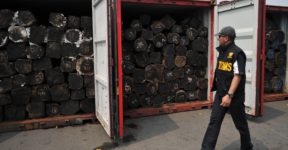
Tackling Deforestation: The Need for Regulation
Forest certification has been pioneering and can play a role in reducing deforestation, but without proper regulation, its impacts will be limited or lost altogether, argue Saskia Ozinga and David Hopkins.
Agricultural conversion is the main cause of forest loss but illegal logging and timber production contribute significantly and, indeed, they are often linked, with logs felled during illegal agricultural conversion finding their way into timber supply chains.
There are different approaches to, and interaction between, voluntary private sector certification initiatives – e.g. those run by the Programme for the Endorsement of Forest Certification (PEFC) and the Forest Stewardship Council (FSC) – and governmental regulatory initiatives taken as part of the EU’s Forest Law, Enforcement, Governance and Trade Action Plan (FLEGT) to improve governance in the forestry sector. Both can play a useful role but, without regulation, the impacts of certification remain limited.
Born from high-profile campaigns by NGOs in the early 1990s, voluntary certification initiatives were pioneers in raising awareness about deforestation and illegal logging.
Seeking to counter the failure of governments to manage forests sustainably, they have helped introduce a corporate environmental management system covering supply chains: from forest concessions to end users.
Certification schemes set strict management standards for forestry companies to meet within their defined concession areas and against which they can be audited for compliance by a verified third party. Those concessions who meet the standards are awarded a certificate.
Timber produced in a certified forest can then be traced as it passes through each step of the supply chain, via a chain-of-custody paperwork system – again an audited process – so that end users can be assured of the provenance of their product.
The products can then bear the logo and brand name of the particular certification scheme whose standards they have met. Brand recognition among end users allowed demand for the schemes to grow.
The impact of certification should not be underestimated: it has played a key role in defining sustainable forest management, setting standards to measure it and developing processes to trace timber across supply chains.
However, arguably, one of the biggest impacts of certification has been the creation of a multi-stakeholder dialogue: the founders of FSC – the oldest certification scheme – realized that, in order to gain credibility, they needed to have equal buy-in from stakeholders representing ecological, social and economic interests. This idea, pioneered by FSC, has since been taken on by most other certification initiatives and to some extent by the FLEGT Programme itself.
Certification’s greatest uptake so far has been in North America and Europe. Here, the certification boom came at a time when businesses were implementing other audited quality management systems (e.g. ISO 9001) so the transition to implementing certification and chain of custody systems was not disruptive. In addition, these regions have high levels of national business regulation covering labour, health and safety, tax payments and so on.
In the tropics, where the need for improved forest management and governance is great, only 6.6 per cent of all certified forests can be found. Even this figure is inflated, as approximately 20 per cent is plantations in Brazil. In Indonesia, only 2.9 million of the 42.3 million hectares of forest estate allocated for concessions are currently FSC certified.
The lack of good governance, coupled with a difference in business culture, has meant that implementing third-party audited management systems has been extremely difficult in many tropical countries. Indeed, the pioneers so far have been companies from Western countries since, for these firms, a system of certification is often the only way to manage risk and control operations within their own business boundaries. However, beyond that boundary, it has little impact.
The FLEGT Programme is not a private initiative but a government process designed to reduce levels of illegal logging and improve forest governance. Central to FLEGT are the legally-binding trade agreements between producer and consumer countries called Voluntary Partnership Agreements (VPAs).
Seven of these VPAs have been ratified – with Cameroon, the Central African Republic, Ghana, Liberia, the Republic of Congo, Indonesia and Vietnam – and six more are being negotiated with Cote d’Ivoire, the Democratic Republic of Congo, Laos, Guyana, Honduras, while negotiations with Gabon and Malaysia have stalled but have not stopped altogether.
As a first step towards a VPA, the government of the timber-producing country must define and approve a legality standard, using an inclusive process that has buy-in from the private sector, local NGOs and ideally from communities too. Once a standard is agreed, a national Timber Legality Assurance System (TLAS) is set up that ensures that only timber certified as legal will get a FLEGT licence. The TLAS is effectively a comprehensive chain of custody system that covers the entire supply chain and all actors – from forest-level producers to processors to exporters at ports.
An independent auditor assesses the system and, in some countries, an independent monitoring system, sometimes run by local civil society organizations, is operational. Regular meetings between the EU and the timber producing country assess progress. These processes mean that FLEGT licences are effectively ‘triple verified’: by independent auditors, independent monitors and annual periodic evaluations.
In most cases, the negotiation of a VPA has led to clarification and reform of the legal framework, and in all cases, it has led to increased transparency, the establishment of more open decision-making processes and better access to information as well as stronger civil society organizations and more forest revenues being distributed to communities.
Important progress has also been made in managing timber supply chains and strengthening independent monitoring of the sector with a decrease in illegalities seen in Indonesia, Cameroon and Ghana.
The EU has adopted complementary regulation only allowing imports into the EU from countries with a FLEGT licence once the TLAS is up and running and has been deemed effective while the EU Timber Regulation (EUTR) has been adopted by the EU requiring companies to execute due diligence and making it a criminal offence to put illegally sourced timber on the EU market. Furthermore, under the EUTR, timber with a FLEGT licence is deemed legal without further controls required.
The multi-stakeholder processes embodied in the VPA have helped to provide a strong sense of ownership of the agreements, including among local NGO actors, which is fundamental for long-lasting reform.
But, FLEGT also has its limitations. Only Indonesia has been able to issue licences so far and only one other country, Ghana, is close. No new VPAs have been ratified since 2018 and no new negotiations have started since 2018. Furthermore, while most FLEGT agreements also cover domestic markets, here there has been little progress in terms of implementation. Nonetheless, the governance improvements in the VPA countries are real and hopefully lasting.
Both certification and FLEGT have their strengths and weaknesses and creating more synergies between them would be useful. But certification faces a number of obstacles to transforming forest practices which FLEGT can help with.
The first is permanence: natural forests are often owned by the state which allocates time-limited harvesting rights to private sector management through concessions. Forest managers therefore have no incentive to commit to the long-term sustainability of a resource they do not own and to which their rights often extend to a single harvest. Furthermore, once a harvest cycle is complete, certified concession holders may be replaced by a different company that does not choose to uphold the same voluntary standard. This means the individual certification brands may not have a permanent impact.
The second is land tenure conflicts: state ownership of natural forests is often contested. In the case of Indonesia, the state ‘grabbed’ the forests of indigenous peoples, known as adat forests, through the adoption of two forestry laws in 1967 and 1999 thereby creating ongoing conflict with indigenous communities.
But Indonesia is not a special case. A study by consultancy The Munden Project looking into 73,000 concessions in eight countries found that 93 per cent of these were on community-owned land. This lack of recognition of community tenure rights is often the basis of conflicts and violence and is difficult to address through certification. Government processes and VPA agreements are better suited to address this injustice.
In Ghana, the VPA spells out the need for legal reform concerning the ‘affirmation of local forest tenure and of different stakeholder rights’ although implementation is slow. Similarly, in Liberia, the VPA process was one of the processes supporting the adoption of the progressive Land Rights Act. In Indonesia, however, the VPA process has not yet properly tackled the illegitimacy of the forest concessions on indigenous lands.
The third is scale: certification is applied to individual forest concessions meaning all the hard work and cost of certifying has no impact on the wider forest estate while auditors are unable to check compliance with legal, environmental or social elements that are framed by wider national policy and for which compliance is a state responsibility.
For example, a 2018 study by Wageningen University covering 6 million hectares of certified forest worldwide, found that although FSC certification produces positive results, in particular for fauna, these are only achieved if certified forests are surrounded by a relatively unfragmented landscape which may be outside the scope of the FSC.
Government-led reforms – such as those instigated by the negotiation and implementation of a VPA – make important contributions to sustainable forestry that are beyond the scope of voluntary certification.
They address the issue of permanence by framing environmental, social and economic standards in legislation and establishing a system that guarantees a long-term perspective which is unlikely to be achieved in situations where individual concession managers may choose to terminate their certification.
They can address injustices related to community land tenure by ensuring that a legality definition is based on international law and customary law as well as national law.
They also overcome the issue of scale as they apply at the national, rather than at the concession level, requiring implementation of improved practices across the entire forest estate.
So, while voluntary certification through schemes such as FSC or PEFC can set a standard for sustainable forest management in individual concessions, government-led reforms and legislation raise standards across the entire forest estate. Combined, they are therefore much more likely to have a significant impact on wider sustainability.
FLEGT-induced governance reforms reduce the costs to a timber producer of attaining FSC or PEFC certification. In a study for IDH Sustainable Trade Initiative, for example, PwC found that VPA implementation would significantly reduce the costs of FSC certification both in Cameroon and Indonesia.
In Cameroon, forestry law and FSC standards are already closely aligned and producers meeting FLEGT requirements would have already incurred around 60 per cent of the costs required to comply with the FSC standards while, for Indonesia, the study suggests that companies who complied fully with all forestry legislation will have incurred on average 68 per cent of the costs of FSC certification and, in some cases, up to 80 per cent.
The impact of certification and FLEGT, however, could be improved in a number of ways. The first is that the costs of certification could be reduced. As the mandatory national standard is increasingly strengthened in VPA producer countries responsible forest managers must now maintain two certification standards.
In Indonesia, for example, companies aspiring to FSC standards must pay for audits for both the national timber legality assurance system (Sistem Verificasi Legalitas Kayu, or SVLK) and for FSC certification with FSC certification costing approximately $11,050 and SVLK certification $13,142. These double payments are counterproductive and present a significant financial barrier to the adoption of FSC by forest managers in Indonesia.
One way forward in the case of Indonesia could be to combine the forest management audits for SVLK and FSC/PEFC. This would demonstrate how the complementary nature of the two schemes can be translated into practical efficiency gains by reducing certification costs and saving time. In turn, combined audits will make it much simpler and cheaper for organizations to move to certified sustainable forest management (SFM) standards.
This would, however, not be possible for other VPA countries where the legality assessment is done through a different process. There, costs could possibly be reduced in the chain of custody process.
One option to look into could be for the certification schemes to defer their chain of custody control systems to the TLAS which is more comprehensive and stricter than chain of custody processes for SFM certification. After all, FLEGT aims to catch the crooks, while certification works with progressive companies.
The second is increasing market access for FLEGT. One of the drivers of the widespread adoption of certification by European producers and distributors is the fact that, early in their development, the certification bodies, backed by NGOs, lobbied European governments to ensure that only certified timber was allowed into public procurement regimes and they were successful. It is now extremely difficult to sell uncertified timber into public sector contracts throughout the EU thereby giving certified timber a competitive market advantage.
But, apart from the UK and Luxembourg, no EU countries accept FLEGT certificates on an equal footing with certified timber. Given the issues described, and the enormous steps taken by producer countries which have signed VPA agreements, is it time for this to change?
Although VPA legality standards may be slightly lower than certification standards, as the IDH study indicates, the difference is often not that big. More importantly, as FLEGT creates systemic changes that certification can build on, it seems important that all EU countries stimulate VPAs by accepting FLEGT certificates in their procurement policy – not accepting them effectively creates a barrier for sustainable forestry.
There is a gap between commitments made to stop deforestation and the reality on the ground where deforestation is increasing. FLEGT and forest certification, even if working together more effectively, cannot alone tackle this.
The reasons for this are, first, because of the growth in domestic and regional markets which are out of reach of certification and insufficiently addressed by the VPAs and, second, because agricultural conversion remains the main cause of deforestation.
Certification has been tried for many agricultural products but it has failed to deal adequately with the environmental and social problems in the sector. Indeed, there is now growing interest in parts of the agricultural sector to look at how to better link the certification of products with legislative proposals.
Take cocoa, for example, the main driver of deforestation in Ghana and Cote d’Ivoire, nearly a quarter of all cocoa produced is certified but this has failed to halt deforestation or to stop the use of child labour.
The Rainforest Alliance and Fairtrade International, together with large companies Mars Wrigley, Mondelez International and Barry Callebaut AG, are now calling on the EU to negotiate bilateral agreements with governments in cocoa-producing countries as well as to establish a demand-side regulatory and policy framework to encourage sustainable cocoa production and sustain market demand for cocoa from West Africa.
The cocoa sector is clearly interested in a regulatory approach along the lines of a VPA and the palm oil sector may not be far behind. Indeed, in April 2020, the Roundtable on Sustainable Palm Oil, which certified around 19 per cent of the world’s palm oil supply in 2018, released a statement supporting an EU Due Diligence Regulation for forest commodities. Such a regulation would be welcome but, as shown by the timber sector, would only be effective if linked with further regulatory incentives to improve governance in the relevant sectors.
To tackle deforestation, we need to improve governance both in the forest sector and the wider land-use sector. That requires government intervention with a focus to improve land governance including participatory land use planning in which the integral role of forests is fully recognized.
Certification has been a great pioneer in the timber sector, as well as in other sectors, but it has to be supplemented by regulations in both producer and consumer countries in order to provide governments with incentives to address permanence, scale and systemic injustices – notably those related to customary tenure.


